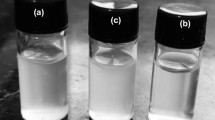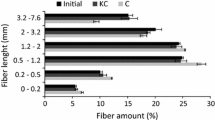Abstract
The objective of this work was to find a rapid, high-yield process to obtain an aqueous stable colloid suspension of cellulose nanocrystals/whiskers. Large quantities are required since these whiskers are designed to be extruded into polymers in the production of nano-biocomposites. Microcrystalline cellulose (MCC), derived from Norway spruce (Picea abies), was used as the starting material. The processing parameters have been optimized by using response surface methodology. The factors that varied during the process were the concentration of MCC and sulfuric acid, the hydrolysis time and temperature, and the ultrasonic treatment time. Responses measured were the median size of the cellulose particles/whiskers and yield. The surface charge as calculated from conductometric titration, microscopic examinations (optical and transmission electron microscopy), and observation of birefringence were also investigated in order to determine the outcome (efficiency) of the process. With a sulfuric acid concentration of 63.5% (w/w), it was possible to obtain cellulose nanocrystals/whiskers with a length between 200 and 400 nm and a width less than 10 nm in approximately 2 h with a yield of 30% (of initial weight).
Similar content being viewed by others
References
Anglès M.N., Dufresne A. (2000) Plasticized starch/tunicin whiskers nanocomposites. 1. Structural analysis. Macromolecules 33:8344–8353
Araki J., Wada M., Kuga S., Okano T. (1998) Flow properties of microcrystalline cellulose suspension prepared by acid treatment of native cellulose. Colloids Surf. A: Physiochem. Eng. Aspects 142:75–82
Araki J., Wada M., Kuga S., Okano T. (2000) Birefringent glassy phase of a cellulose microcrystal suspension. Langmuir 16:2413–2415
Beck-Candanedo S., Roman M., Gray D.G. (2005) Effect of reaction conditions on the properties and behavior of wood cellulose nanocrystal suspension. Biomacromolecules 6: 1048–1054
Dong X.M., Revol J.-F., Gray D.G. (1998) Effect of microcrystalline preparation conditions on the formation of colloid crystals of cellulose. Cellulose 5: 19–32
Dufresne A., Cavaillé J.Y. (1999) Nanocomposite materials of thermoplastic polymers reinforced by polysaccharide. ACS Symp. Ser. 723: 39–54
Edgar C.D., Gray D.G. (2002) Influence of dextran on the phase behavior of suspensions of cellulose nanocrystals. Macromolecules 35: 7400–7406
Eichhorn S.J., Young R.J. (2001) The Young’s modulus of a microcrystalline cellulose. Cellulose 8: 197–207
Favier V., Chanzy H., Cavaillé J.Y. (1995) Polymer nanocomposites reinforced by cellulose whiskers. Macromolecules 28:6365–6367
Helbert W., Cavaillé J.Y., Dufresne A. (1996) Thermoplastic nanocomposites filled with wheat straw cellulose whiskers. Part I: processing and mechanical behavior. Polym. Comp. 17:604–610
Herzog R.O., Gonell H.W. (1924) Röntgenspektrographischer vergleich von tunicin und lichenin mit zellulose. Hoppe-Seyler’s Z. Physiol. Chem. 141: 63–67
Katz S., Beatson R.P., Scallan A.M. (1984) The determination of strong and weak acidic groups in sulfite pulps. Sven. Papperstidn. 6:48–53
Marchessault R.H., Morehead F.F., Koch M.J. (1961) Some hydrodynamic properties of neutral suspensions of cellulose crystallites as related to size and shape. J. Colloid Sci. 16:327–344
Marchessault R.H., Morehead F.F., Walter N.M. (1959) Liquid crystal systems from fibrillar polysaccharides. Nature 184:632–633
Montgomery D.C. (2001) Design and Analysis of Experiments. John Wiley & Sons, New York
Mukherjee S.M., Woods H.J. (1953) X-ray and electron microscope studies of the degradation of cellulose by sulphuric acid. Biochim. Biophys. Acta 10: 499–511
Nickerson R.F., Habrle J.A. (1947) Cellulose intercrystalline structure. Ind. Eng. Chem. 39: 1507–1512
Orts W.J., Godbout L., Marchessault R.H., Revol J.-F. (1998) Enhanced ordering of liquid crystalline suspensions of cellulose microfibrils: a small angle neutron scattering study. Macromolecules 31:5717–5725
Ranby B.G. (1952a) Physico-chemical investigations on bacterial cellulose. Ark. Kemi 4: 249–257
Ranby B.G. (1952b) Physicochemical investigations on animal cellulose (Tunicin). Ark. Kemi 4: 241–248
Ranby B.G. (1952c) The cellulose micelles. Tappi 35: 53–58
Revol J.-F., Bradford H., Giasson J., Marchessault R.H., Gray D.G. (1992) Helicoidal self-ordering of cellulose microfibrils in aqueous suspension. Int. J. Biol. Macromol. 14: 170–172
Sturcova A., Davies G.R., Eichhorn S.J. (2005) Elastic modulus and stress-transfer properties of tunicate cellulose whiskers. Biomacromolecules 6: 1055–1061
Tashiro K., Kobayashi M. (1991) Theoretical evaluation of three-dimensional elastic constants of native and regenerated celluloses: role of hydrogen bonds. Polymer 32: 1516–1526
Acknowledgements
We thank the Research Council of Norway for financial support and Borregaard ChemCell in Sarpsborg, Norway, for providing us with MCC. We also thank Kristin Brevik Antonsen and Dr. Simon Ballance at the Department of Biotechnology at the Norwegian University of Science and Technology for providing us with the necessary equipment used in this research, Associate Prof. John Tyssedal at the Department of Mathematical Sciences at the Norwegian University of Science and Technology for discussions regarding statistics, Christer Albano at Umetrics for discussions concerning model design, Dr. Bjørn Steinar Tanem for TEM images, and PhD-student Ingvild Kvien for TEM images and WAXD analysis.
Author information
Authors and Affiliations
Corresponding author
Rights and permissions
About this article
Cite this article
Bondeson, D., Mathew, A. & Oksman, K. Optimization of the isolation of nanocrystals from microcrystalline cellulose by acid hydrolysis. Cellulose 13, 171–180 (2006). https://doi.org/10.1007/s10570-006-9061-4
Received:
Accepted:
Published:
Issue Date:
DOI: https://doi.org/10.1007/s10570-006-9061-4




